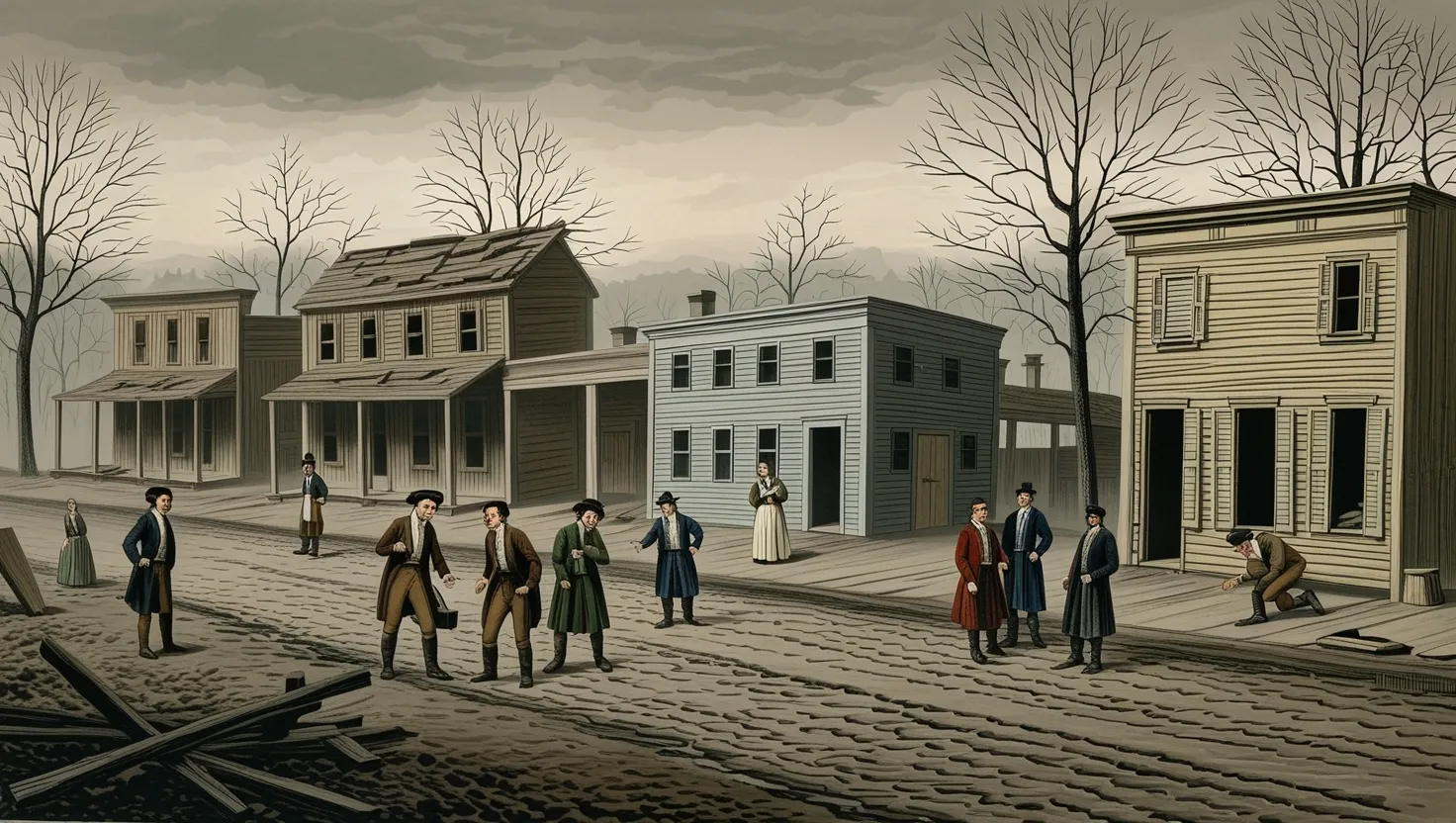Imagine living in a country where the lines between economic boom and outright disaster blur overnight. The Panic of 1837 transformed that line into a chasm. People woke to headlines shattering their sense of wealth. Banks simply closed. Men with yesterday’s fortunes found themselves penniless. But just how did speculation in land—a gamble in soil, timber, and hope—bring an expanding America to its knees? The answer is far more layered than the simple “bubble bursts” story told in many textbooks.
For a nation fueled by the dream of western expansion, land didn’t just mean opportunity. It was currency, status, and—most dangerously—a ticket to quick riches. I find it hard to overstate just how feverish this speculation became. Picture plots of forest in Maine, or prairies far from any road, selling for multiples of their real value simply because someone else would pay more the next day. In Massachusetts, some banks pinned their future on timberland that, in hindsight, was almost worthless—too remote, too wild, or bought at such a price it could never pay off. What, we might ask, made all this possible?
It started with the destruction of the Second Bank of the United States. Andrew Jackson called this fight his victory for the common man. “I have always been afraid of banks,” he once declared, “[they] are more dangerous than standing armies.” With central supervision gone, hundreds of state banks sprung up. The floodgates opened: banks could issue paper money with little to back it but their own assurances.
New land made recently available—thanks to the forced removal of Native Americans—became the focus of waves of speculation. Borrowing was easy, and banks didn’t bother much with collateral checks. It’s striking to read that between 1830 and 1836, the number of banks more than doubled. Per capita, Americans held 40 percent more paper money in their hands in just two years. Do you see the seeds of trouble? When everyone bets on prices always rising, what happens when they stop?
There’s something else, often missed. British money propped up much of this boom. The low interest rates in England—combined with a search for new profits—sent a tide of gold and silver across the Atlantic. Investors who knew little of Ohio or Mississippi poured funds into American banks and trading houses. When the Bank of England faced trouble at home, it called in these loans. Suddenly, America’s credit balloon lost its lift—gold and silver stopped coming, and bills came due.
Jackson’s Specie Circular sealed the system’s fate. In 1836, he demanded that land buyers use hard money—gold or silver—not paper currency. Why this step? He saw land prices spiraling out of control and believed hard money would bring stability. In practice, it drained eastern banks of their coin as it rushed westward, leaving banks across the country exposed, unable to pay those wanting to redeem their notes. Suddenly, the paper in everyone’s pockets became worth far less than promised. Imagine turning in a $10 bill and getting just a shrug in return.
On May 10, 1837, New York banks stopped redeeming paper money for specie. News spread by telegraph and word of mouth. Bank closures multiplied, cascading across the country. In weeks, hundreds of banks failed. Main Streets emptied of business. Unemployment soared. Cotton, then king among American commodities, lost half its value. The plantations of the South, whose owners counted on British buyers, found themselves with mounting debts and no easy exit.
“Speculation is only a word covering the making of money out of the manipulation of prices, instead of supplying goods and services.” That observation, from Henry Ford, could have been written about those years. Land that once secured loans found itself worthless as purchasers evaporated.
What strikes me as especially tragic is how the optimism of the broader society transformed, almost overnight, into fear and suspicion. Average people, who believed their local bankers or politicians would surely act to help them, watched as relief never arrived. The federal government itself was caught in the storm—revenues shrank, debts mounted, and without a central bank, there was little coordination in response. President Martin Van Buren, who inherited this whirlwind, chose a hands-off approach. “The less government interferes with private pursuits, the better for the general prosperity,” he insisted. But was that true in an existential panic?
American states, left to their own devices, often made things worse. Some defaulted on foreign debts. Public works, like railroads and canals, ground to a halt mid-construction, their funding vanished. Infrastructure’s expansion, a symbol of the very progress that land speculation was meant to deliver, became a casualty of speculation’s collapse.
It wasn’t just land that became unstable ground. Farmers lost their homes to foreclosure. Urban unemployment soared—especially in cities like New York, where joblessness reached a level not seen before. Breadlines grew, a new and jarring sight in bustling American towns. And yet within this misery, innovation couldn’t—and didn’t—pause. The use of coal, the development of machine tools, the first railroads pushing ever westward, all persisted, hints that even in downturns, adaptation never sleeps.
So what are we left to learn? I often ask myself: would things have been different with a strong national bank at the helm, or if speculation was checked sooner? The lessons feel perpetually relevant. Asset bubbles, it turns out, are not confined to the 19th century. Modern financial crises—think of 2008—echo many of these rhythms.
But here’s a perspective we don’t often find in economic treatises. The panic was also profoundly international. The collapse of British credit, shifts in global money, swings in cotton prices in Liverpool—all played a role. America’s domestic policy choices, no matter how bold, couldn’t shield a growing economy from the world’s volatility. Isn’t it odd, then, how financial nationalism—removing the central bank, pushing for “sound money”—created conditions where global currents could do the most harm?
Congress responded by gradually designing systems to separate public money from private hands, birthing the Independent Treasury System. This principle, that government funds needed insulation from local or state bank failures, eventually echoed down to the founding of the Federal Reserve. Each shift, in effect, admitted a new reality: economic exuberance needs brakes, and the brakes must work nationally and internationally alike.
What about the human stories behind these sweeping changes? Diaries, letters, and newspaper columns from 1837 brim with uncertainty and anger. “I was rich yesterday; I am beggared today,” wrote one merchant. For many, the most infuriating part was how success seemed based not on practical hard work, but on fickle prices and luck. Can we imagine a better way to structure opportunity—with enough checks on speculation without stifling growth?
Some of the most valuable, though subtle, lessons come from where the crisis did the least harm. Boston’s main banks, for example, were more cautious—they required higher levels of hard money in reserve, even when easy profits beckoned. By resisting the madness, they stayed solvent, proving that prudence isn’t just old-fashioned; it’s occasionally heroic.
In the end, can any system guarantee prosperity unbroken? The Panic of 1837 suggests otherwise. Each generation’s optimists remake the boundaries of what is possible, and each must contend with the wreckage of their excess. Yet the cycle of speculation and collapse isn’t just a tale of finance—it’s a reminder of how collective beliefs create, then destroy, worlds.
“History doesn’t repeat itself, but it often rhymes,” Mark Twain is said to have quipped. If so, then studying 1837 is like recognizing an old tune in a modern market: familiar notes, played with new instruments, and the same chance for catastrophe or creation.
Why do we believe, again and again, that new lands or new assets—whether railroad shares, suburban housing, or digital tokens—will only rise in value? And what, if anything, can we do to balance ambition with restraint? The Panic of 1837 leaves us with these questions, still as immediate today as they were nearly two centuries ago—a reminder that the price of prosperity is attention, skepticism, and, on rare occasion, the courage to say no when everyone else is shouting yes.
As you pause to consider the next rising market, remember: each Bubble starts not with fraud, but with trust—misplaced, overextended, sold and resold—until the music stops. The lesson buried in the soil and timber of 1837 is not that speculation is evil, but that unchecked optimism is always expensive. And just maybe, wisdom lies as much in pausing as in pressing forward.






